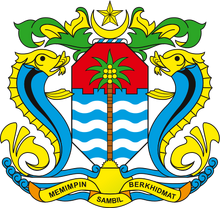
Logo of the Penang Island City Council.
Penang Island, Malaysia's most populous island city[1], is located off the northwestern coast of Peninsular Malaysia. It lends its name to the State of Penang, which also consists of a strip of mainland Malay Peninsula called Seberang Perai. Its capital city, George Town, is located at the northeastern tip of the island.
Founded by Captain Francis Light in 1786, Penang Island was the first British crown colony in Southeast Asia. George Town's historic city centre has been listed as a UNESCO World Heritage Site since 2008[2].
The island city is one of Malaysia's most developed and economically vital cities, serving as Malaysia's Silicon Valley[3] as well as a popular tourist destination. It has earned acclaims by the likes of The Guardian[4], CNN[5], Los Angeles Times[6] and Forbes[7]. Furthermore, both Forbes and CNN has listed George Town as one of the best budget cities to retire in the world[8][9]. George Town was also ranked 8th. in the ECA International's list of most liveable cities in Asia[10]. Additionally, Penang Island is Malaysia's centre of medical tourism[11] and northern commercial centre.
Its heterogeneous and multilingual population has Malaysia's third highest Human Development Index[12]. A native of Penang Island is colloquially known as a Penangite (in English) or a Penang lang (in Penang Hokkien dialect).
History
Founding of Penang
Penang Island was actually discovered in the 15th. century. Chinese navigators who were sailing as part of Admiral Zheng He's treasure fleets had mapped the island as Bīnláng Yù.
In 1592, an Englishman by the name of Sir James Lancaster became the first European to land on Penang Island. Arriving on the northern shores of Penang Island, he and his crew pillaged every vessel within the vicinity, before sailing back to England in 1594[13].
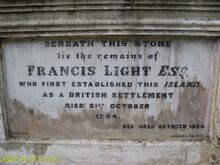
Captain Francis Light passed away in Penang in 1794. His grave can still be seen at Farquhar Street, George Town.
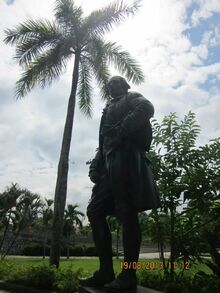
A statue of Captain Francis Light still stands within the gorunds of Fort Cornwallis, George Town.
However, the modern history of Penang Island only began in 1786, when Captain Francis Light, a trader for the British East India Company, founded Penang Island on 17 July. Fort Cornwallis was later built on the spot where he landed. Light then obtained the island from the Sultan of Kedah "in the name of His Britannic Majesty, King George III and the Honourable East India Company" and founded a settlement at the northeastern point of the island.

Fort Cornwallis in George Town marks the spot where Captain Francis Light first landed on 17 July 1786.
On 12 August 1786, Light renamed the island the Prince of Wales Island in honour of the heir to the British throne, as well as naming the new settlement George Town in honour of King George III. The Prince of Wales namesake was in use until after 1867, when the island was renamed Penang Island[14].
George Town was Britain's first settlement in Southeast Asia, as well as the first crown colony in Malaya. Light chose to colonise Penang Island due to its strategic location at the northern entrance to the Strait of Malacca, a vital shipping route between British India and Qing China. its northern location also enabled the British to check French and Dutch expansion in Southeast Asia.
The colonisation of Penang Island also marked the beginning of more than a century of British involvement in Malaya.
Light established George Town as a free port to entice traders away from Dutch ports in the region. Trade in Penang soon grew exponentially - incoming ships and boats to Penang rose from 85 in 1786 to 3,569 in 1802[15]. Light also encouraged immigrants by firing silver dollars from his ship's cannons into the jungle and promising them as much land as they could clear. By 1792, just six years after Light first arrived on the island, the population had grown from under 100 to over 10,000[16].
Unbeknownst to the Sultan of Kedah, Light had acted without the approval of the British East India Company when he promised military protection and then concealed the facts of the agreement from both parties[17]. When the company failed to aid Kedah against a Siamese invasion, the Sultan tried to retake the island in 1790. The attempt was unsuccessful, and the Sultan was forced to cede the island to the company for an annual honorarium of 6,000 Spanish dollars. This was later increased to 10,000 dollars, with the cession of Province Wellesley (now Seberang Perai) to the company in 1800. Seberang Perai remains part of the state of Penang to this day; as a symbolic gesture, the Penang state government still pays the neighbouring state of Kedah RM10,000 annually[18].
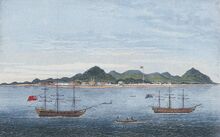
1810 painting of George Town. Fort Cornwallis can be clearly seen at the seafront.
Colonial Penang
In 1796, Penang was made a penal settlement when 700 convicts were transferred from the Andaman Islands[19]. This began a long-standing practice of employing Indian convict workers as low-cost labourers. Many worked on Penang's streets, draining swamps and clearing forests, building drainage ditches, and installing the piping for clean water. Main roads were extended from George Town into the fertile cultivated spice farms further inland. Indeed, convict labour was key to Penang's successful colonisation; many were later employed in the civil service, military and as private servants to British officials and private individuals.

An 1884 map of George Town
Penang's trade was initially driven by the demand in pepper, spices, Indian piece goods, betel nut, tin, opium and rice[20]. Betel nut can be found abundantly on the island, while tin was channelled from the Malay Peninsula. However, it was the spice production that the British colonial authorities saw the greatest potential, as they sought to break the Dutch monopoly on spice trade within Southeast Asia[21]. Therefore, they sought to expand Penang Island's spice industry by encouraging Chinese settlers to set up spice farms inland[22][23]. Even the British mansions along the northern coast of George Town contained spice gardens. This agricultural trade enabled the British to cover Penang's administrative expenses and to dominate the spice trade between Southeast Asia and Europe[19].
In 1794, the British had introduced clove and nutmeg to Balik Pulau at the southwestern part of Penang Island[24]. The establishment of the agricultural town of Balik Pulau attracted Malay refugees fleeing the Siamese invasion of Kedah and Chinese immigrants who worked on the agricultural estates.
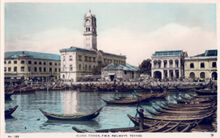
George Town, Penang in the early 20th. century.
In 1826, George Town was made the capital of the newly established Straits Settlements, which also consisted of Singapore and Malacca[25]. However, the capital was moved to Singapore in 1832 due to Singapore's booming trade.
In spite of this, Penang retained a secondary importance after Singapore, serving as an important feeder to Singapore - funnelling the exports meant for global shipping lines by ocean-going ships which had bypassed other regional ports.
In 1867, the Penang Riots erupted in George Town for nine days, as rival Chinese secret societies battled each other over commercial interests[26]. The rioting was only quelled after the British authorities, under newly appointed lieutenant-governor Col. Edward Anson, called in sepoy reinforcements from Singapore.
Trade was expanded greatly with the opening of the Suez Canal in 1869[27]. By then, rubber cultivation was becoming an important industry on mainland Malay Peninsula. Rubber was sent to Singapore and Penang to be traded and shipped to the United Kingdom, where the Industrial Revolution generated increasing demands for these commodities. Towards the end of the 19th. century, the tin mining boom in the neighbouring Sultanate of Perak also made George Town one of the biggest entrepots in Malaya, rivalling the Port of Singapore in terms of tin exports.[28]

Jewish cemetery in George Town. The last Jew in Penang passed away in 2011, bringing an end to Penang's Jewish community.
Due to its prosperity, Penang Island also attracted immigrants from far and wide, turning the island into a ethnic and religious melting pot. Aside from Chinese, Malay, Indian, Eurasian (mixed European and Asian ancestry) and Peranakan (mixed Sino-Malay ancestry) immigrants, Jews, Armenians and Germans made their presence felt in Penang. There was a sizeable Jewish enclave in George Town[29] and a financially-influential German merchant community[30], while the Armenians left their legacy in the form of one of the most famous hotels in the city, the Eastern & Oriental Hotel[31].
At the southeastern part of Penang Island, the agricultural town of Bayan Lepas was established by the end of the 19th. century[32]. Legend has it that a wealthy Sumatran family had landed on the shores of Bayan Lepas and in the ensuing commotion, their pet parakeet escaped, hence the name Bayan Lepas ('escaped parakeet' in Malay). Bayan Lepas remained a rural agricultural area surrounded by paddy fields until 1935, when the Penang International Airport was opened. Bayan Lepas would be transformed for good in the 1970s, due to a momentous decision that saved Penang's economy.
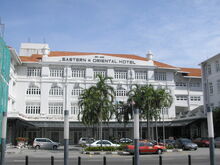
The Eastern & Oriental Hotel, at Farquhar Street, George Town, was founded by the Sarkies brothers, who also established the Raffles Hotel in Singapore.
At the start of the 20th. century, Penang Island, with a large Chinese community, was an obvious choice for Sun Yat-sen's revolutionary campaign to overthrow the Qing dynasty which ruled China[33]. His frequent visits culminated in the 1910 Penang conference which funded the victorious Wuchang Uprising that overthrew the Manchu government.
World Wars
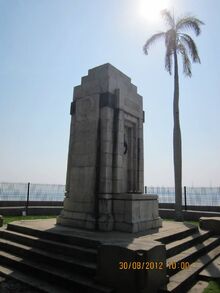
The Cenotaph at The Esplanade in George Town commemorates the fallen Allied servicemen of World War 1.
During World War 1, Penang Island was mostly untouched, save for the 1914 Battle of Penang. In the battle, the Imperial German Navy cruiser SMS Emden surreptitiously sailed to the island, and sank the Russian cruiser Zhemchug and the French destroyer Mousquet off its coast[34].
At the start of World War 2, George Town suffered devastating Japanese aerial bombardments from 11 December 1941[35]. As casualties mounted from the indiscriminate air raids, the British authorities decided to silently evacuate Penang's European population, leaving the rest of Penang's Asian population to their fates[36]. British forces also started to withdraw from Penang, abandoning the Batu Maung Fort, and declared George Town an open city. The defenceless island was left in the hands of a State Committee which had to subdue civil unrest and violence.
The British withdrawal and the covert evacuation of Europeans caused much disillusionment and injury to the British prestige and image of invincibility. Historians judge that "the moral collapse of British rule in Southeast Asia came not at Singapore, but at Penang"[37].

Ethnic Malay and Chinese women from Penang taken by the Imperial Japanese Army.
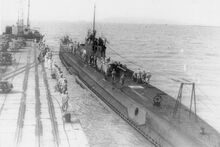
An Imperial Japanese Navy submarine in Penang in 1942.
Penang Island finally fell to the Imperial Japanese Army on 19 December 1941. The Imperial Japanese Army quickly used the only radio station on the island to broadcast a chilling message - "Hello, Singapore, this is Penang calling. How do you like our bombing?"[35].
The Japanese occupation was marked by widespread fear, hunger and the Sook Ching massacres which targeted the local Chinese[38]. Especially notorious was the Japanese military police Kempeitai and its network of informants. The Japanese also took Malay and Chinese girls as comfort women[39].
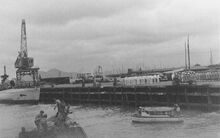
A Kriegsmarine (Nazi Germany Navy) U-boat in George Town during World War 2.
George Town also served as a U-boat base for Nazi Germany's Navy (Kriegsmarine) during the War[40].
The Royal Air Force and United States Army's Twentieth Air Force began bombing raids on the island in 1944[41]. The destruction of the Penang Secretariat building by Allied bombers in the final months of the occupation caused the loss of the greater part of the British and Japanese records concerning the island, causing enormous difficulties to compile a comprehensive history of Penang. In addition, the Battle of the Malacca Strait took place off Penang Island in May 1945, in which the British Royal Navy sank a Imperial Japanese Navy warship[42].
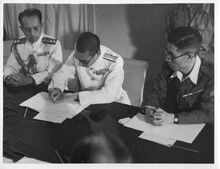
A Japanese official signing the Penang surrender document on the Royal Navy battleship, HMS Nelson.
On 21 August 1945, the Penang Shimbun published a statement of surrender issued by the Emperor of Japan[41]. Under Operation Judice, a Royal Navy fleet arrived off Penang Island on 28 August. After the signing of the Japanese surrender document on 2 September, a detachment of the Royal Marines occupied the island on 3 September. A formal ceremony to signify British repossession of Penang took place on 6 September 1945.
Independence
Two successive British military governors under the British Military Administration took over the administration of Penang from 1945 to 1946[43].
Following the humiliating British defeat at the hands of the Japanese during World War II, the British sense of invincibility were permanently lost, and for most locals, the days of the British Empire were numbered. In 1946, the Straits Settlements were dissolved, with Sir Shenton Thomas being the last governor[25]. The British then included Penang, but excluded Singapore, into a consolidated federation of Malayan states. The Malayan Union was formed in 1946, only to be replaced by the Federation of Malaya two years later due to Malay opposition.
However, the idea of the merger of the British crown colony of Penang into the vast Malay heartland was opposed by some Penangites[44]. The Penang Secessionist Movement (active from 1948 to 1951) attempted to prevent Penang's merger with Malaya, but was ultimately voted down by the British[45][46]. A petition sent to London also met with British disapproval[47][48]. The movement was led by some of the most influential commercial associations in Penang, including the Penang Chinese Chamber of Commerce, the Penang Indian Chamber of Commerce, and the Penang Clerical and Administrative Staff Union.

A newspaper report on the petition to award city status to George Town.
On 1 January 1957, George Town was declared a city by Her Majesty Queen Elizabeth II, becoming the first city in the Federation of Malaya, and the only city in Malaysia (other than Singapore between 1963 and 1965) until 1972, when Kuala Lumpur was granted city status[49].
Penang, as a state in the Federation of Malaya, gained independence in 1957, and subsequently became a member state of Malaysia in 1963.
Post Independence
Since independence, the Penang state government has been headed by the Chief Minister of Penang. For the first two decades, the Chief Minister was Wong Pow Nee of the Malaysian Chinese Association (MCA), a component party of the Alliance (now Barisan Nasional) ruling coalition[50].
In the 1969 elections, Penang was captured by the then opposition party, the Malaysian People's Movement Party (Gerakan)[51]. Party founder, Dr. Lim Chong Eu subsequently became the second Chief Minister. However, the 1969 Kuala Lumpur race riots ensued and as an emergency measure, the state government was taken over by the National Operations Council. Civilian rule was restored in 1971 and the following year, Gerakan joined the Alliance, returning Penang to the ruling coalition for the next 36 years[52][53].
Since the first days of British rule, George Town had been a free port. This free port status was suddenly revoked in 1969, causing massive unemployment as high as 16% and loss of trade, as well as setting the stage for George Town's decline[54][55].
The Malaysian federal government then began to focus on developing Port Klang and Kuala Lumpur, directing economic development through its control over investment in communication, transport, education and health[56]. Consequently, Kuala Lumpur began replacing George Town as Malaysia's financial hub. Younger residents in George Town moved out into the suburbs, while Penang also began to suffer a brain drain.
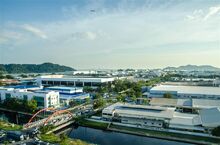
Bayan Lepas Free Industrial Zone
To resolve Penang's economic woes, the then Chief Minister Dr. Lim Chong Eu created the Bayan Lepas Free industrial Zone adjacent to the Penang International Airport[57][58]. By offering pioneer tax status, foreign investors and multinational electronic giants began setting up factories and assembly plants, paving the way for Penang to be known as the 'Silicon Valley of the East'.

KOMTAR, Penang's tallest skyscraper.
In 1974, the KOMTAR project, intended to revitalise George Town, was launched. Penang's tallest skyscraper was completed in 1988, but it failed to revitalise George Town and came at great costs - the destruction of historical shophouses, schools and temples[56].
In 1976, the George Town City Council was merged with the Penang Rural District Council to form the Municipal Council of Penang Island[59]. This merger led to the controversy over George Town's city status. The Malaysian federal government no longer regarded George Town as a city[60]. Nevertheless, most Penangites contended that George Town remains a city to this day. On the other hand, several federal ordinances and acts refer to the City of George Town, such as the City of George Town Ordinance 1957. According to Penang Heritage Trust (PHT) trustee and lawyer, Datuk Anwar Fazal, George Town "legally has been and is still a city because the City of George Town Ordinance 1957 had not been repealed"[61].

Penang Bridge
The Penang Bridge linking Penang Island with mainland Peninsular Malaysia was opened for use in 1985 by the then Malaysian Prime Minister Tun Dr. Mahathir bin Mohamad, who drove across the bridge in the first Malaysian-made car, the Proton Saga[62]. It was then the longest bridge in Southeast Asia.
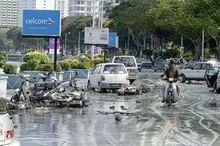
Aftermath of the 2004 Indian Ocean tsunami at Gurney Drive, George Town.
The Indian Ocean tsunami of 2004 hit the northern coasts of Penang Island, claiming 52 lives[63].
Renaissance
The repeal of the Rent Control Act that had protected George Town's pre-war architecture led to the dilapidation of the city centre and uncontrolled development, raising concerns over the preservation of George Town's heritage buildings (George Town has Southeast Asia's largest collection of pre-war houses)[64]. These led to increased conservation efforts and a media campaign in 2004 to restore George Town's glory.
The media campaign in 2004 was also fueled by the obvious neglect of Penang under the ruling Barisan Nasional; at the time, George Town's decay, garbage-strewn streets, dirty beaches and traffic congestion even prompted Malaysia's ex-Prime Minister Dr. Mahathir Mohamed to label Penang "Pulau Pinang Darul Sampah" (Penang the Abode of Garbage)[65][66].
Conservation efforts finally paid off when in 2008, George Town was awarded the UNESCO World Heritage Site listing, due to its "unique architectural and cultural townscape without parallel anywhere in East and Southeast Asia"[2].
Also in 2008, an alliance of opposition parties, led by the Democratic Action Party (DAP), won the Penang state elections, taking over the Penang state government and wiping Gerakan out of existence[67][68]. Under the current Chief Minister, Lim Guan Eng, Penang has been able to significantly slash its state debt[69] and has been as one of Malaysia's most attractive investment destinations[70]. George Town's appeal as a clean, artistic, historical city has also been growing[71], reversing the decades of neglect by the ruling Barisan Nasional[56].
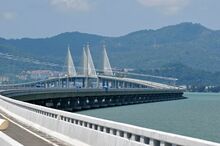
The Second Penang Bridge, the longest bridge in Southeast Asia.
The Second Penang Bridge, currently the longest bridge in Southeast Asia, was opened for use in 2014[72]. This longer bridge is a more southerly entrance into Penang Island, linking Batu Maung near its southeastern tip with the mainland peninsula.

The Penang City Hall once again serves as the city council headquarters since 2015.
Whilst George Town had been declared a city by Her Majesty Queen Elizabeth II in 1957, Penang Island was also awarded city status by the Malaysian federal government in 2015[73].
Government and Politics
Penang Island City Council
At present, the Penang Island City Council administers the entire Penang Island. Its responsibilities include urban planning, heritage preservation, public health, sanitation, waste management, traffic management, environmental protection and infrastructure maintenance.
The Penang Island City Council is the successor of the Municipal Council of George Town, which was Malaysia's first ever local authority. Between 1957 and 1972, George Town was also the only city in Malaysia (other than Singapore between 1963 and 1965). By 1965, the George Town City Council was Malaysia's richest local authority.
The Penang state government appoints the councillors[74]. The Mayor of Penang Island, who is assisted by a secretary, is appointed for two years, while the 24 councillors are each appointed for one-year terms in office[75].
List of Mayors
Mayors of George Town
Between 1 January 1957 and 1966, George Town was led by three successive mayors.
| # | Mayor | In Office |
|---|---|---|
| 1 | D. S. Ramanathan[49] | 1957–1961 |
| 2 | Ooi Thiam Siew[76] | 1961–1964 |
| 3 | Choy Chooi Yew[77] | 1964–1966 |
Mayors of Penang Island
| # | Mayor | In Office |
|---|---|---|
| 1 | Patahiyah binti Ismail[78] | 2015–present |
Penang State Government
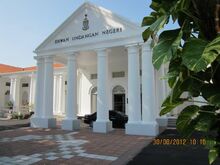
The State Assembly Building at Light Street, George Town, serves as the legislative 'Parliament' for the State of Penang.
Since 2008, the Penang state government has been controlled by an alliance of opposition parties, the Democratic Action Party (DAP) and the People's Justice Party (PKR)[68]. On the island, the DAP controls 12 seats and the PKR has four seats. The remaining three seats are held by UMNO, the ruling party in the Malaysian federal government.
There has been political tension between the Penang state government and the Malaysian federal government. Since its defeats in the 2008 and 2013 elections, the UMNO-led Malaysian federal government has been intensifying its bias towards Penang, notably by denying financial assistance for the Penang Transport Master Plan[79][80] and excluding Penang from Malaysia's special cities list which promised greater budget allocation[81].
List of Penang Island representatives in the Penang State Legislative Assembly.
| Parliament | State | Seat Name | State Aseemblyman | Party |
|---|---|---|---|---|
| P.048 | N.22 | Tanjong Bunga | Teh Yee Cheu | DAP |
| P.048 | N.23 | Air Puteh | Lim Guan Eng | DAP |
| P.048 | N.24 | Kebun Bunga | Cheah Kah Peng | PKR |
| P.048 | N.25 | Pulau Tikus | Yap Soo Huey | DAP |
| P.049 | N.26 | Padang Kota | Chow Kon Yeow | DAP |
| P.049 | N.27 | Pengkalan Kota | Lau Keng Ee | DAP |
| P.049 | N.28 | Komtar | Teh Lai Heng | DAP |
| P.050 | N.29 | Dato Keramat | Jagdeep Singh Deo | DAP |
| P.050 | N.30 | Sungai Pinang | Lim Siew Khim | DAP |
| P.050 | N.31 | Batu Lanchang | Law Heng Kiang | DAP |
| P.051 | N.32 | Seri Delima | R. Nethaji Rayer | DAP |
| P.051 | N.33 | Air Itam | Wong Hon Wai | DAP |
| P.051 | N.34 | Paya Terubong | Yeoh Soon Hin | DAP |
| P.052 | N.35 | Batu Uban | Jayabalan A. Thambyappa | PKR |
| P.052 | N.36 | Pantai Jerejak | Mohd. Rashid Hasnon | PKR |
| P.052 | N.37 | Batu Maung | Abdul Malik Abdul Kassim | PKR |
| P.053 | N.38 | Bayan Lepas | Nordin Ahmad | UMNO |
| P.053 | N.39 | Pulau Betong | Muhamad Farid Saad | UMNO |
| P.053 | N.40 | Telok Bahang | Shah Haedan Ayoob Hussain Shah | UMNO |
Malaysian Federal Parliamentary Representation
Penang Island is represented with six seats in the Malaysian federal Parliament.
List of George Town representatives in the Malaysian federal Parliament.
| Parliament | Seat Name | Member of Parliament | Party |
|---|---|---|---|
| P.048 | Bukit Bendera | Zairil Khir Johari | DAP |
| P.049 | Tanjong | Ng Wei Aik | DAP |
| P.050 | Jelutong | Ooi Chuan Aun | DAP |
| P.051 | Bukit Gelugor | Ramkarpal Singh a/l Karpal Singh | DAP |
| P.052 | Bayan Baru | Sim Tze Tzin | PKR |
| P.053 | Balik Pulau | Hilmi Yahaya | UMNO |
Judiciary
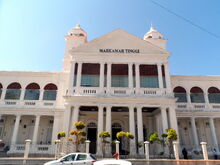
Penang Island served as the birthplace of the Malaysian legal system[82]. In 1807, a Royal Charter of Justice to form a police force and a Court of Justice was granted by King George III. The Supreme Court of Penang was initially sited at Fort Cornwallis, George Town in 1808. Sir Edmond Stanley assumed office as the first Supreme Court Judge in Penang, becoming the first ever judge to serve on Malaysian soil. Interestingly, Sir Stamford Raffles, who would later go on to found Singapore, was the first registrar of the Supreme Court of Penang.
Today, Penang's courts consist of the Magistrates, Sessions and the Supreme Court of Penang at Light Street, George Town[83].
The Syariah court is a parallel court which hears matters concerning Islamic jurisprudence.
Geography
Topography
Penang Island is Malaysia's fourth largest island, with an area of 295km2, about 40% the size of Singapore Island. It is also Malaysia's most populous island and has the highest population density of all Malaysian islands, at about 2,559.7/square km. As of 2012, according to the Penang Institute estimates, about 738,500 people are living within the island.
The highly urbanised and industrialised island can be distinguished into five areas.
- Its capital city of George Town is sited on the island's northeastern flat promontory; the dense urban area is the administrative, cultural and economic centre of Penang.
- The southeast, which covers the town of Bayan Lepas, the Free Industrial Zone and the Penang International Airport, was once a swampy mangrove and rice fields. More townships and residential areas are being developed here. Consequently, Bayan Lepas has expanded northwards and linked up with George Town's southernmost suburb of Gelugor. Thus, the entire eastern seaboard of Penang Island has been urbanised.
- The central hill ranges serve as the island city's vital green lung. Penang Hill has a height of 735 metres, the highest point on Penang Island. The neighbouring suburbs of Air Itam and Paya Terubong are located in the valley between the hill ranges.
- The thin strip of beaches to the north, covering Tanjung Tokong, Tanjung Bungah and Batu Ferringhi suburbs, is lined with hotels, resorts and luxurious residences.
- The sparsely populated southwest is relatively less developed, consisting of scenic countryside, fishing villages, fruit orchards and mangroves. The town of Balik Pulau gains fame from its particularly fragrant durians.
Due to Penang Island's small size and its mostly hilly features, land reclamation has been conducted to prepare suitable low-lying land for more development, such as at Tanjung Tokong[84], Jelutong[85] and Queensbay[86].
Climate
Penang Island features a tropical rainforest climate, under the Köppen climate classification. Temperatures in Penang remain constant throughout any given year, between 22°C and 32°C.
Shielded from the northeastern monsoon by the mountains of the Malay Peninsula, the driest months are between December and February. The wettest period is usually from September to November; frequent thunderstorms can be expected in these months. The island sees on average around 2,550 mm (100.4 in) of precipitation annually.
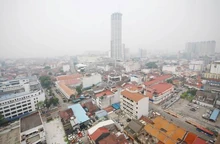
2015 haze in George Town, Penang.
Like most of Malaysia and Singapore, Penang also faces the annual haze between July and October, due to agricultural fires in Indonesia[87].
The Bayan Lepas Regional Meteorological Office serves as the main weather forecast facility for northern Malaysia.
Outlying islets

Pulau Jerejak, off the southeastern coast of Penang Island.
There are less than 10 islets surrounding Penang Island. The largest of all is Pulau Jerejak, just off the southeastern coast of Penang Island. It was here that Captain Francis Light first set foot before landing on Penang Island[88]. There was a leper asylum on Pulau Jerejak; it later served as a maximum-security penal colony. Now, the lushly-forested island is a tourist attraction, hosting a spa resort.
Other islets include Pulau Aman, Pulau Betong, Pulau Kendi and Pulau Rimau.
Greater Penang Conurbation
The Greater Penang Conurbation is the second largest metropolitan area in Malaysia after Greater Kuala Lumpur, with a population of approximately 2.5 million[89]. The metropolitan area is centred in George Town and covers the entire State of Penang, along with the surrounding areas in the neighbouring Sultanate of Kedah.
Other than Penang Island, among the areas covered under the conurbation are as follows.
On mainland Seberang Perai:
- Butterworth
- Bukit Mertajam
- Nibong Tebal
- Kepala Batas
In Kedah :
- Sungai Petani
- Kulim
- Bandar Baharu
Economy
*All monetary figures are quoted in Malaysian Ringgit (RM), unless stated.
Penang has Malaysia's third largest economy[90] and is one of the top investment destinations[70] (13% of Malaysia's total investments between 2008 and 2013)[91], as well as having one of Malaysia's highest GDP per capita (RM 42,251 as of 2015)[92].
The two sectors which contributed the most to Penang's GDP are manufacturing, which includes the electronics and semiconductor industries which gave Penang its 'Silicon Valley of the East' moniker[3], and services, which has seen rapid growth due to the island's booming tourism industry[93].
Unemployment in Penang was at a historic low of 1.2% by 2015 and remains consistently lower than the rest of Malaysia[94]. In addition, Penang's Gini coefficient (which measures income inequality, with lower scores denoting lower inequality) was reduced to 0.37 in 2012, lower than the national average of 0.43[95].
Manufacturing

Bosch headquarters in the Bayan Lepas Free Industrial Zone.
As the 'Silicon Valley of the East', the manufacturing sector contributed as much as 48.3% of Penang's GDP in 2013[96]. Machinery and transport equipment also accounted for 71% of Penang's total exports for the first nine months of 2014.
The Bayan Lepas Free Industrial Zone is home to the factories and assembly plants of many multinational firms specialising in electronics and engineering. Among them are Bosch[97], Intel[98], Dell[99], Motorola[100], Agilent[101], Seagate[102], Osram[103] and Plexus Corporation[104].
In 2011, Penang received manufacturing investments of up to RM 9.1 billion, the highest in Malaysia[105]. In fact, the increase in total investments enabled the Penang state government under the DAP to slash public debt by 95%, from RM 630 million in 2008 to RM 30 million in 2012[106]. American media firm, Bloomberg, described Penang's growth as Malaysia's "biggest economic success" despite the Malaysian federal government's bias against Penang[70].
Services
Penang's services sector not only contributed 47.4% of Penang's GDP in 2013, it is expected to be Penang's top GDP-contributing sector in the next few years, overtaking the manufacturing industry[96]. Almost two-thirds of Penang's workforce are employed in this sector.
The rapid growth of the services sector is largely driven by Penang Island's reputation as a major tourism destination in the region[107]. Medical tourism, wholesale and retail trade, accommodation, food and beverages, as well as shared services and outsourcing (SSO) are among the thriving sub-sectors which fueled Penang's service industry.
In the coming years, Penang is also expected to see a more active services sector due to increased investments from Singaporean firms[108]. Singapore's state-owned investment firm, Temasek Holdings, has plans to construct a two-block Business Process Outsourcing Prime within Bayan Lepas.
Medical Tourism
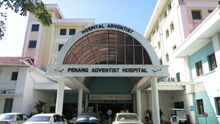
Penang Adventist Hospital, one of the many private hospitals in George Town.
George Town has been Malaysia's centre of medical tourism, receiving at least half of medical tourist arrivals in Malaysia[11]. An estimated 1,000 tourists travel to Penang every day for medical treatment[109], generating about 70% of Malaysia's medical tourism revenue[110]. Most tourists come from neighbouring countries such as Indonesia and Singapore.
Penang's several private hospitals, such as the Penang Adventist Hospital and the Lam Wah Ee Hospital, offer treatments conducted by well-trained health professionals at more affordable costs.
Wholesale and Retail Trade
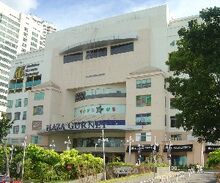
Gurney Plaza is one of George Town's most famous shopping malls.
Penang Island is the main shopping destination for northern Malaysia. George Town has a unique retail scene, with centuries-old shophouses still operating alongside flea markets and numerous modern shopping malls in the city. Elsewhere on the island, hypermarkets and supermarkets also serve the suburban population alongside shopping malls.
Furthermore, the numerous shopping complexes throughout Penang Island has made it the entertainment centre for northern Malaysia.
Others
The establishment of hotels and budget hostels has been picking up pace in George Town, along with boutique cafes and restaurants in the heritage zone. This provided for a more vibrant accommodation, and food and beverages (F&B) sub-sectors.
Banking

Standard Chartered Bank Building at Beach Street, George Town
George Town was once the centre of banking of Malaysia at a time when Kuala Lumpur was still a small outpost. The oldest bank in Malaysia, Standard Chartered Bank (then the Chartered Bank of India, Australia and China) opened its doors in 1875 to cater to the financial requirements of early European traders[111]. The Hongkong and Shanghai Banking Corporation, now known as HSBC, opened its first branch in George Town in 1884[112]. This was followed by a Dutch bank in 1888[113].
Today, George Town remains the banking hub of northern Malaysia, with branches of Oversea-Chinese Banking Corporation[114], United Overseas Bank[115], Citibank[116] and Bank of China[117], as well as Malaysian banks such as Bank Negara Malaysia (the Malaysian central bank), Public Bank, Maybank, Ambank and CIMB.
Agriculture
The agricultural sector on Penang Island is very small and includes fisheries, aquaculture, and new emerging industries such as ornamental fish and floriculture. Balik Pulau is home to the only surviving paddy field on Penang Island. But perhaps the most famous of Penang's agricultural produces are Balik Pulau durians[118] and nutmegs[119].
Tourism
Penang Island has always been a popular tourist destination, both domestically and internationally. As of 2014, Penang attracted 6.84 million tourists[120], and counts among its tourists Somerset Maugham, Rudyard Kipling[121], Queen Elizabeth II[122] and Lee Kuan Yew[123].
In recent years, Penang Island has been acclaimed internationally. Among some of the plaudits are as follows.
- The Los Angeles Times has placed Penang island as one of the 16 must-see destinations of 2016, citing the city's most historic architecture and its lively food scene[6].
- The Lonely Planet has named George Town as one of the top 10 cities for travel in 2016[124]. Previously in 2014, Robin Barton of the Lonely Planet listed George Town as the top culinary destination in the world[125].
- Forbes has named George Town the best budget tourist destination for 2016[7]. In 2014, Forbes had also listed George Town as one of the best budget cities for retirement[8].
- CNN has placed George Town as one of Asia's top street food cities[5]. In 2016, George Town was placed sixth in CNN's top 10 places to retire in the world, the highest among Asian cities.[9]
- The British newspaper, The Guardian had also listed Penang as a top 10 destination in 2014[4].
Historical

Fort Cornwallis, George Town is Malaysia's oldest and largest fort.
George Town's city centre has been accorded the UNESCO World Heritage Site status since 2008, due to its "unique architectural and cultural townscape without parallel anywhere in East and Southeast Asia". The enclave consists of colonial buildings built during the heyday of British rule over the Straits Settlements, such as the Penang City Hall and the Supreme Court of Penang, Chinese shophouses with their ubiquitous five foot ways and places of worship of various religions.

Jubilee Clock Tower, George Town, commissioned in 1897 for Queen Victoria's Diamond Jubilee.
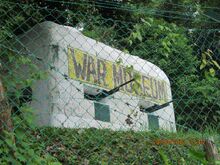
A pillbox in the Penang War Museum
A former British Army bastion at the southeastern tip of Penang Island, the Penang War Museum serves as a chilling reminder of the horrors of World War 2. It was originally designed to defend against an sea-borne invasion of Penang. It turned out to be a disastrous mistake, as the Imperial Japanese Army advanced on land down the Malay Peninsula instead. Armed with cannons and light machine guns, British and Commonwealth troops nevertheless abandoned the fort without a fight, withdrawing ahead of the Japanese landing on Penang Island.
Heritage & Culture
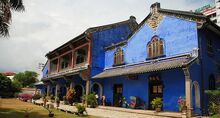
Cheong Fatt Tze Mansion at Leith Street, George Town

The Pinang Peranakan Mansion at Church Street, George Town is a fine example of Peranakan architecture.
The Cheong Fatt Tze Mansion was built in the 1880s by Chinese master craftsmen. The famous indigo-blue Chinese Courtyard House in George Town was the residence of Chinese Consul and businessman Cheong Fatt Tze. Its impressive hybrid Chinese-European architecture aside, it possesses a rare collection of sculptures, carvings, tapestries and other antiques.
The Pinang Peranakan Mansion is actually a former residence of a Chinese Kapitan, Chung Keng Kwee. The mansion was rehabilitated and turned into a museum which showcases Peranakan antiques. Here, one can get a glimpse of the lives of the Peranakans, also known as the Straits Chinese or the King's Chinese, who descended from interracial Sino-Malay marriages. The Peranakans had formed the wealthier class in the Straits Settlements and were fiercely loyal British subjects, distinguishing them from the more recent Chinese immigrants at the time[126].

Penang Snake Temple in Bayan Lepas
Also known as the Temple of Supreme Bliss, Kek Lok Si is said to be the largest Buddhist temple in Southeast Asia. Its main draw is the striking seven-storey Pagoda of Rama VI (Pagoda of 10,000 Buddhas) and 30.2m bronze statue of Kuan Yin, the Goddess of Mercy.
The Snake Temple in the Bayan Lepas Free Industrial Zone is another temple worth visiting. As the name implies, it is probably the only Chinese temple in the world which hosts snakes. The temple also holds a unique fortune-telling ceremony, which is based on the flames of the censer every Chinese New Year.

Children on a Bicycle mural by Ernest Zacharevic at Armenian Street, George Town.

A wrought iron caricature at Victoria Street, George Town.
Creative forms of street art can be found throughout George Town. The trend was started by Lithuanian artist, Ernest Zacharevic, who began painting a series of wall murals in various parts of the city in 2012. They now stand as Penang's celebrated cultural landmarks, with Children on a Bicycle being one of the most photographed spots in the city[127]. Since then, the arts scene has flourished, with the addition of humourous wrought iron caricatures and an exhibition centre at the former Hin Bus Depot.
In addition, Penang plays host to a unique form of Chingay parade. Popular throughout Malaysia and Singapore, Penang's version of Chingay parade contains the unique giant flag-balancing performance.
Food
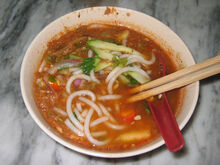
Penang asam laksa
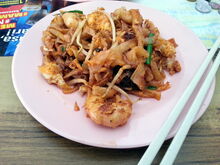
Penang's char kuey teow is said to be different from its Singaporean counterpart due to the latter's sweeter taste.
As Malaysia's food capital, Penang Island is frequented by locals, Malaysians and foreign tourists alike. Penang cuisine reflects the city's history as a cultural melting pot, offering a diverse and exotic mix of Chinese, Malay, Indian, Peranakan, European and Thai influences.
Local Penangites have differing views on where to sample the best of any particular Penang food. Some of the more famous of Penang dishes can be found within George Town, such as Penang Road's famous chendol, Gurney Drive's seafood, Air Itam's asam laksa and Pulau Tikus's Hokkien mee. Within the heritage zone, Kimberley Street, in particular, comes alive at night, offering a wide variety of street food. Several tau sar pneah shops can also be found throughout the city, selling delectable bean paste biscuits. Meanwhile, the best durians are said to be cultivated in Balik Pulau.
Penang was recognised as having the best street food in Asia by the Time magazine in 2004, citing that "nowhere else can such great tasting food be so cheap"[128]. In 2014, Penang was named the top food destination worldwide by Robin Barton of the Lonely Planet[125]. According to Barton, "its food reflects the intermingling of the many cultures that arrived after it was set up as a trading port in 1786, from Malays to Indians, Acehenese to Chinese, Burmese to Thais. State capital Georgetown is its culinary epicentre." In 2016, The Culture Trip website also listed Penang as one of the best cities in the world for food[129]. Meanwhile, CNN has named Penang as one of Asia's 10 greatest street food cities[5].
Beaches
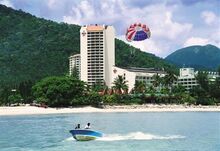
Parasailing off Batu Ferringhi beach.
The most popular beaches are located at the northern coast of Penang Island, which is also the northwestern edge of George Town. The contiguous beaches of Tanjung Tokong, Tanjung Bungah and Batu Ferringhi are home to George Town's famed hotel and resort belt.
The Penang National Park at the northwestern tip of Penang Island also covers more pristine beaches like Pantai Kerachut and the Muka Head lighthouse, which serves as a beacon for vessels entering Penang waters from the north.
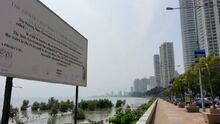
Other than that, Gurney Drive is the most popular seafront promenade in George Town. The area includes Gurney Plaza and Gurney Paragon shopping malls, as well as the adjacent Gurney food court. Gurney Drive also has Penang's most modern and developed skyline, due to the high-rise hotels and skyscrapers lining the seaside.
Other popular promenades in George Town are The Esplanade in the middle of the heritage zone and the Karpal Singh Drive within the Jelutong suburb.
Shopping

Queensbay Mall, Penang's largest shopping mall, is located in Bayan Lepas.
Penang Island serves as the main shopping destination in northern Malaysia. While most of the major shopping malls are located within George Town, some modern shopping malls can be found to the south as well, such as Queensbay Mall and Bukit Jambul Complex.

Street markets in George Town exude an atmosphere akin to 1960s Singapore.
Within George Town, traditional bazaars such as the Chowrasta Market and Campbell Street, and makeshift open-air night markets known as pasar malam, were the precursors to today's shopping malls. They offer goods ranging from modern electronics and textiles to foodstuffs and local produce. Traditional Chinese and European shophouses are also still active, offering tourists a unique retail experience with an old world charm. Several traditional shophouses have also been refurbished into trendy boutique cafes, restaurants and budget hostels, adding to the city's vibe.
Nature
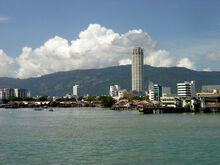
Penang Hill, at the background, constantly forms a verdant backdrop to Penang's skyline.
The most popular natural tourist attraction is the Penang Hill. At 735 metres, its peak is the highest point of Penang Island, giving visitors an unparalleled view of the entire island as well as Seberang Perai and Kedah on mainland Peninsular Malaysia. To get to the top, tourists can either take Malaysia's only funicular train, hire a 4-wheel drive or hike up the hill.
The Botanical Gardens, which also includes a youth park and the adjacent waterfall, has been George Town's green lung since its establishment in 1884[130]. It is open to the public daily.
The Penang National Park, at the northwestern tip of Penang Island, is the world's smallest national park[131]. It remains as one of the few protected forest reserves on the heavily urbanised island, covering coastal forests, mangroves and pristine beaches.

Tropical Spice Garden
Adjacent to the national park are another two well-known parks, the Tropical Spice Garden and the Penang Butterfly Farm. The Tropical Spice Garden consists of over 500 species of herbs and spices throughout the tropical world[132], while the Butterfly Farm is the first tropical butterfly farm set up in the tropical world, with an average flying population of 4,000 butterflies of 120 different species[133].
Culture and Heritage
Festivals
Penang's cultural mosaic naturally means that there are a great many number of festivals to celebrate in any given year.
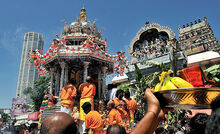
Thaipusam in George Town.
The Chinese celebrate, among others, the Chinese New Year, Mid-Autumn Festival, Hungry Ghost Festival, Qing Ming, and the celebrations of various Taoist deities. The Malays and Muslims celebrate Hari Raya Aidilfitri, Hari Raya Haji, and Maulidur Rasul, while Hindus observe Deepavali, Thaipusam and Thai Pongal. Christmas, Good Friday and Easter are celebrated by Christians. Buddhists also observe Wesak Day while the Sikhs celebrate Vaisakhi.
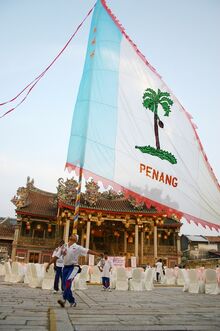
Penang version of Chingay.
Aside from these festivities, Penang plays host to a unique form of street parade, known as the Chingay. George Town hosted the first ever Chingay parade in Southeast Asia in 1905[134]. Since then, Chingay parades have spread throughout Singapore and Malaysia. Penang's version of the Chingay parade is unique in that the balancing of giant flags on the forehead or hands is an essential performance, compared to the Chingay parades elsewhere in Malaysia. It was said that after the 1972 ban on firecrackers in Singapore had dampened the Chinese New Year festive mood, the then Singaporean Prime Minister Lee Kuan Yew suggested the staging of a Chingay parade similar to those held in Penang, even to the extent of borrowing the flag-balancing performance from the Penang version[135].
The Penang state government organises the annual George Town Festival which celebrates the city's World Heritage Site status with arts and live cultural performances throughout the month of July or August. With over 100 unique events each year, the George Town Festival is quickly becoming one of Asia’s must-see cultural events.
Every Sunday, the Occupy Beach Street event sees a stretch of Beach Street in George Town being turned into pedestrian-friendly zones filled with recreational and fun social activities[136].
New Year's Day festivities are usually held at various spots throughout Penang Island. In the morning, an annual City Walk is held within the UNESCO World Heritage Site to commemorate George Town's city status which was granted on 1 January 1957, drawing thousands of people[137].
Bon Odori is an annual event held at The Esplanade by the expatriate Japanese population.
Architecture
Penang's architecture is a durable testament of her history – a culmination of over a century and a half of British rule, as well as the confluence of immigrants and the mingling of various cultures.
Fort Cornwallis, right next to The Esplanade, was among the first British structure built in George Town. Outstanding examples of colonial period buildings include the City Hall, the European-style banks' headquarters along Beach Street, the Penang State Museum, the Eastern & Oriental Hotel and St. George's Church – all of which are located within the UNESCO World Heritage Site.
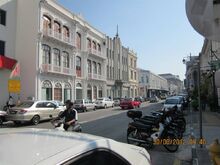
The Suffolk House, the former residence of Penang's British governors, on the banks of the Air Itam river is an example of the Anglo-Indian garden house. The stately Seri Mutiara (formerly known as the Residency), completed in 1890 as the residence of Penang's British Resident Councillors, is today the official residence of the Governor of Penang.
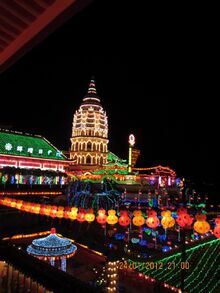
Kek Lok Si temple during the night of Chinese New Year.
Chinese influence is visible at the many ornate clan houses, temples, pre-war shophouses, and mansions such as the Cheong Fatt Tze Mansion. The Clan Jetties are a collection of water villages at Weld Quay.
As a former Straits Settlement, Peranakan influence is also visible in Penang's architecture, a prominent example being the Pinang Peranakan Mansion.
The Indian community built many elaborate temples such as the Mahamariamman temple, while Muslim influence can be seen at the Kapitan Keling Mosque, the Acheh Mosque, and the Penang Islamic Museum. Meanwhile, the P. Ramlee Museum is an excellent example of traditional Malay stilt houses.

Wat Chaiyamangkalaram is a famous Thai Buddhist temple in the suburb of Pulau Tikus.
Thai and Burmese architecture can be appreciated within the suburb of Pulau Tikus, as can be seen at Wat Chaiyamangkalaram and Dhammikarama Buddhist temples. Meanwhile, the Kek Lok Si temple in the suburb of Air Itam contains a fusion of Thai, Burmese and Chinese architecture.
Modern structures and skyscrapers also abound in George Town, sometimes side by side with heritage buildings. To this day, the KOMTAR tower remains the tallest skyscraper in Penang.
Performance Arts
Boria is a traditional dance drama indigenous to Penang, featuring singing accompanied by violin, maracas and tabla.
Chinese opera (usually the Teochew and Hokkien versions) is frequently performed throughout the island, often in specially built platforms, especially during the annual Hungry Ghost Festival. There are also puppetry performances, although they are not as frequently performed today.
Museums and Galleries
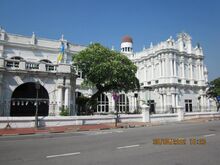
The Penang State Museum houses relics, photographs, maps, paintings and other artefacts that document the history and culture of Penang and its people.

Camera Museum, Muntri Street, George Town
George Town also houses several other museums such as the Camera Museum, Batik Painting Museum, the Sun Yat-sen Museum and the Penang Islamic Museum.

In the Penang Time Tunnel at Green Hall Road, George Town, tourists are allowed to take pictures of numerous murals and exhibits.
More recently, a few 3D visual museums have been opened in George Town, including the Made-in-Penang Interactive Museum and the Penang Time Tunnel[138][139].
Media
Other than the mainstream dailies in national publication, the Penang state government publishes its own multilingual newspaper, the Buletin Mutiara, which is given for free every fortnight. The Penang-centric newspaper focuses on the current issues affecting Penang.
In 2011, the Chief Minister of Penang, Lim Guan Eng officiated the launch of Time Out Penang, which is currently published in three versions - a yearly printed guide, a regularly updated website and mobile app.
George Town's well-preserved urban landscape has been used as a backdrop in several movies, notably Anna and the King and Lust, Caution. Some Singaporean Chinese drama series, such as The Little Nyonya and The Journey: Tumultuous Times, were also filmed in George Town, due to the similar old-world architecture that both former Straits Settlements used to share, but which was lost in Singapore after decades of urban development.
The following is a list of available FM radio stations on Penang Island, including the Penang-based Mutiara FM.
| Frequency | Station | Operator | Language |
|---|---|---|---|
| 87.8 | One FM | Media Prima | Mandarin, Cantonese |
| 88.2 | Hot FM | Media Prima | Malay |
| 89.9 | Fly FM | Media Prima | English |
| 91.0 | Mix FM | AMP Radio Networks | English |
| 92.8 | Hitz FM | AMP Radio Networks | English |
| 93.9 | Mutiara FM | RTM | Malay |
| 94.5 | 988 FM | Star RFM Radio | Mandarin, Cantonese |
| 94.9 | Klasik FM | RTM | Malay |
| 96.7 | Minnal FM | RTM | Tamil |
| 97.1 | Sinar FM | AMP Radio Networks | Malay |
| 98.1 | Red FM | Star RFM Radio | English |
| 98.7 | TraXX FM | RTM | English |
| 99.3 | THR FM | AMP Radio Networks | Tamil |
| 99.7 | My FM | AMP Radio Networks | Mandarin, Cantonese |
| 101.3 | Ai FM | RTM | Mandarin, Cantonese, Hokkien |
| 102.4 | Suria FM | Star RFM Radio | Malay |
| 103.6 | Era FM | AMP Radio Networks | Malay |
| 104.4 | Lite FM | AMP Radio Networks | English |
| 107.6 | Capital FM | Star RFM Radio | English |
Transportation
As one of Malaysia's major cities, Penang Island is relatively more well-connected by air, land and sea, compared with other Malaysian islands.
History

A tram in George Town. In the past, the city could boast of having the best transportation system in Malaysia.
In the past, George Town had the best public transportation system in Malaysia, with electric trams, trolleybuses and also double-decker buses plying its streets. The first steam tramway started operations in the 1880s[140], while electrical trams were launched in 1905. Trolleybuses commenced operations in 1925 and they gradually supplanted the trams[141]. The George Town Municipal Transport (GTMT) operated both the trams and the trolleybuses. It was famous for the smallest public trolleybuses in operation. In the 1950s, the GTMT bought ex-London trolleybuses. Despite having purchased new Sunbeam British trolleybuses in 1957, the trolleybus system was abandoned in 1961. The use of double-decker buses ceased in the 1970s while the network was being taken over by private buses.

A trolleybus in George Town
One of the earliest modes of transportation in George Town was the horse hackney carriage which was popular throughout the last quarter of the 18th century until 1935, when the rickshaw (jinriksha) gained popularity, until it in turn was rapidly superseded by the trishaw beginning in 1941. Cycle rickshaws and trishaws are still in use within George Town today, mostly for sightseeing rides.
Meanwhile, Penang's air and sea links were also developed during the colonial era. Under the Straits Settlement government, the Penang International Airport was opened in 1935[142]. The Penang Ferry Service began its operations in 1920, linking George Town with the town of Butterworth on mainland Malay Peninsula[143].
Roads, Highways and Bridges

The Second Penang Bridge, the longest bridge in Southeast Asia.
Penang Island is connected to the Malay Peninsula by the Penang Bridge and the Second Penang Bridge. While the older Penang Bridge links the suburb of Gelugor with the Perai Industrial Zone on mainland Peninsular Malaysia, the more southerly Second Penang Bridge links Batu Maung on the southeastern tip of Penang Island to Batu Kawan on the mainland. Opened in early 2014, it is currently the longest bridge in Southeast Asia.
The Tun Dr. Lim Chong Eu Expressway connects George Town to the Penang Bridge, the Bayan Lepas Free Industrial Zone and the Penang International Airport. With this highway, trips to the airport were cut short to 30 minutes instead of almost an hour in the past.
George Town has an extensive road network dating back to the first days of British colonial rule. Outside the narrow streets of the city centre, more modern roads link George Town with the surrounding suburbs of Tanjung Tokong, Air Itam, Jelutong and Gelugor, as well as beyond.
Public Transportation
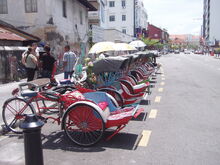
Trishaws at Penang Road, known as beca in Malay, are normally used by tourists.

This particular Rapid Penang CAT bus offers free rides within George Town city centre. Elsewhere on the island, a ride can cost between RM1.40 to RM4.00. (Prices are quoted in Malaysian Ringgit.)
Rapid Penang is the sole bus company in Penang. It now operates about 30 routes on Penang Island. Most buses connect George Town to other parts of Penang Island, with Weld Quay being the main terminal and KOMTAR being the main hub. Rapid Penang also operates a free daily bus service around George Town, taking commuters and tourists on a drive along George Town's famous heritage sites. Recently, open-air double decker buses, known as Hop-On Hop-Off buses, have been introduced for tourists.
George Town also has numerous cycle rickshaws and trishaws plying its streets. It is one of the few cities in Southeast Asia where cycle rickshaws and trishaws still ply the streets.
To facilitate easier and more flexible movement for tourists in George Town's heritage zone, rental bicycles are being introduced and marketed by several companies in George Town[144]. Efforts are being carried out by the Penang state government to make Penang Island a cyclists' haven and a pedestrian-friendly city, including by introducing dedicated cycling lanes[145].
Since 2015, Uber has been in widespread use throughout Penang[146].
Express buses now stop at the Sungai Nibong Bus Terminal to the south between George Town and the airport, instead of KOMTAR previously. There are several express bus companies operating round the clock, and the main destinations include Kuala Lumpur, Singapore and southern Thailand.
Rail

The Penang Hill Railway, the only working rail system on Penang Island. This funicular train coach is relatively new, being introduced into service in 2011.

An old tram line at the junction between Chulia Street and Penang Road in George Town.
George Town used to operate both trams and trolleybuses. The early tramway system had been steadily replaced in the mid-20th century by trolleybuses, first introduced in 1925. In the 1950s, ex-London Transport trolleybuses were brought into the city. Despite having purchased new Sunbeam British trolleybuses in 1956/7, the trolleybus system was abandoned in 1961. To this day, tram lines can still be seen in the city centre[147].
The only rail-based transportation currently available on Penang Island is the Penang Hill Railway, a funicular railway to the top of Penang Hill. It is also the only cable car rail system of its kind in Malaysia. It was an engineering feat of sorts when completed in 1923.
Penang Transport Master Plan
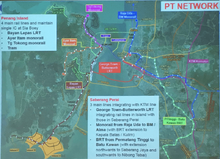
The Penang Transport Master Plan envisages trams in George Town, LRT and monorail lines linking the city to its southern, western and northwestern suburbs as well as the airport, and even a cable car and an undersea tunnel connecting the city with the mainland.
Since 2013, the Penang state government has been mooting the Penang Transport Master Plan[148]. The plan envisages, among others :
- A Light Rail Transit (LRT) line from KOMTAR to the Penang International Airport, as well as monorail lines connecting KOMTAR with the suburbs of Air Itam, Paya Terubong and Tanjung Tokong,
- An overhead cable car linking George Town and Butterworth on mainland Malay Peninsula[149], and
- An undersea tunnel linking Gurney Drive and mainland Malay Peninsula, the third link between the island and the peninsula[150].
With the completion of the plan slated in 2065, the Penang state government aims to have multiple public transportation systems on the ground, at sea and even in the air.
Due to intensifying political conflicts, as of 2016, the Barisan Nasional-led Malaysian federal government has refused to fund the project[80]. It is understood that the Penang state government intends to proceed with the plan, with or without federal assistance.
Airport
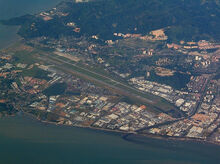
The Penang International Airport is located 14km to the south of George Town.
The Penang International Airport is one of the oldest airports in Malaysia, being opened in 1935 when Penang was governed as a Straits Settlement[142]. Also one of the busiest airports in Malaysia, it serves as the main airport of the northern part of Malaysia. The airport has good connections to major Asian cities, such as Kuala Lumpur, Singapore, Bangkok, Jakarta, Hong Kong, Guangzhou and Taipei.
The airport is the hub of two Malaysian low-cost carriers, Airasia and Firefly. As the second busiest Malaysian airport in terms of cargo traffic, the Penang International Airport also serves as an important cargo hub due to the large presence of multinational factories in the nearby Bayan Lepas Free Industrial Zone.
The Penang International Airport won the Best Emerging Airport (Asia) award in the 23rd annual Asian Freight and Supply Chain Awards 2009 (AFSCA) and Airport of the Year (below 15 million passenger annually) in the 2009 Frost and Sullivan Asia Pacific Aerospace and Defence Awards[151].
The airport has been a source of contention between the Penang state government and the Malaysian federal government. In recent years, calls by the Penang state government to expand the airport largely went unheeded by the Malaysian federal government, even though the airport is reaching its maximum capacity of 6.5 million passengers[152].
Ferries
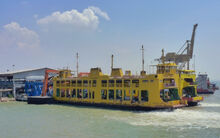
Penang ferries at the Butterworth ferry terminal.
The Penang Ferry Service connects George Town with Butterworth. It is the oldest ferry service in Malaysia; it commenced operations in 1920[143]. Currently, four ferries ply the Penang Strait between George Town and Butterworth every day[153]. Although the ferry service, which is run by a federal government-linked commission, has been incurring losses, the ferry service continues to be a convenient mode of transportation for local Penangites travelling to Butterworth.
Separate ferry services also connect Penang Island with the island of Langkawi to the north[154].
Seaport and Shipping
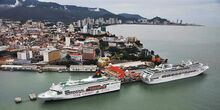
Cruise ships at the Swettenham Pier on George Town's northeastern coast.
The Port of Penang is one of the major ports of Malaysia[155], although the Port of Singapore's pre-eminence as the Southeast Asia's entrepot, the loss of George Town's free port status and the development of Port Klang have reduced its importance somewhat[56][156]. The former Straits Settlement harbour is now operated by the Penang Port Commission. There are four terminals - one on George Town's northeastern coast (Swettenham Pier) and three on the mainland. With Malaysia being one of the largest exporting nations in the world, the Port of Penang plays a leading role in the nation's shipping industry, linking Penang to more than 200 ports worldwide.
Swettenham Pier mainly accommodates cruise ships[157]. Cruise tourism is one of the major industries in George Town; as of 2014, Swettenham Pier attracted 1.2 million tourists to George Town and drew some of the largest cruise liners in the world, such as the RMS Queen Mary 2[120]. A number of cruise ships also call Swettenham Pier as their homeport, bringing tourists into and out of George Town towards regional destinations such as Singapore and Phuket.
On occasion, Swettenham Pier plays host to warships of several navies, such as the Republic of Singapore Navy[158], the Royal Australian Navy[159], the Royal Thai Navy[160], the United States Navy[161] and the Royal Canadian Navy[162].
Sports
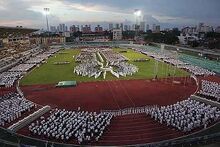
Penang City Stadium, George Town
A number of sporting facilities are located on Penang Island, including the Nicol David International Squash Centre which was named after Nicol Ann David. The top squash player was born in Penang.
The City Stadium in George Town is currently the home of the Penang state football team and is famous for vociferous home support dubbed the "Keramat Roar".
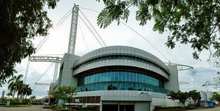
SPICE Arena, Bayan Baru, has been used to host international sporting events, conferences, exhibitions and banquets.
The SPICE Arena in Bayan Baru to the southeast serves as an integrated indoor stadium, swimming complex and as a MICE (Meetings, Incentives, Conferences and Events) venue. Certain national and international level sporting events are held here.
The Penang Turf Club is the oldest of its kind in Malaysia.
The sole golf course on the island is located in Bukit Jambul to the south.
Penang Island also plays host to two annual international dragon boat races, the Penang International Dragon Boat Festival (PIDBF) and the Penang Pesta Dragon Boat Race. Dragon boat races are normally held at the Teluk Bahang dam at the northwestern part of the island.
Another popular annual event is the Penang Bridge Marathon. A year-end event, the marathon route covers either the Penang Bridge or the Second Penang Bridge. The marathon attracted about 28,000 runners in 2015.
Education
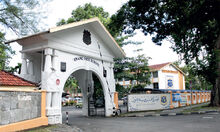
Penang Free School's front entrance
George Town is home to some of the oldest schools in the region; these schools were established during the earliest days of British rule and has educated the most influential lawmakers, politicians, professionals and businessmen.
In recent years, several international schools have been established on Penang Island to cater for a sizeable expatriate population. International schools, which offer up to A-level and International Baccalaureate curriculum, also serve as a higher-quality alternative for local Penangites seeking to send their children abroad for further studies.
In terms of tertiary education, Penang Island has a public university - Universiti Sains Malaysia. It is one of the top research universities in Malaysia. Other than that, Penang Island is the northern centre for many private colleges in Malaysia.
Penang's relatively well-educated populace is reflected in the fact that Penang has the third highest Human Development Index in the nation[163].
English Schools
George Town is one of a few cities in Malaysia with several missionary schools. These are Christian and English-language schools which were founded back in the first days of British colonial era.
Although these schools have been nominally absorbed into the national public schooling system as national schools, these schools still maintain a sense of English tradition.
- Penang Free School
- Methodist Girls' School
- Convent Green Lane
- Convent Pulau Tikus
Chinese Schools
Chinese schools in George Town have brilliant reputations of producing high-quality students, which are highly-sought after.
Some of these schools are privately-funded and offer the Unified Examination Certificate (UEC), which is recognised by universities abroad such as in Singapore, Taiwan and China[164]. The UEC is not accepted by Malaysian public universities, resulting in UEC graduates leaving Malaysia for further studies.
- Chung Ling High School
- Penang Chinese Girls' High School
- Heng Ee High School
- Han Chiang High School
- Phor Tay High School
- Chung Hwa Confucian High School
- Convent Datuk Keramat
International Schools
- Dalat International School
- International School of Penang (Uplands)
- Tenby International School
- Prince of Wales Island International School
- Fairview International School
- St. Christopher’s International Primary School
- Pelita International School
- Straits International School
Tamil Schools
At present, Tamil education is limited to Tamil public primary schools.
- SJK(T) Azad
- SJK(T) Ramakrishna
- SJK(T) Jalan Sungai
Colleges
- Penang Medical College
- KDU College
- SEGi College
- SENTRAL College
- Olympia College
- INTI University College
- Equator Academy of Art
- Han Chiang College
- Wawasan Open University
Tertiary Education
Universiti Sains Malaysia
Health Care
Health care in Penang Island is provided by public as well as private hospitals. The public health care system, first established by the colonial authorities, was supplemented by health care provided by local Chinese charities, and Christian missionaries such as Roman Catholics and the Seventh-day Adventist.
The Penang General Hospital is George Town's only public hospital and a tertiary-care regional referral centre. In addition, the Balik Pulau Hospital serves the sparsely-populated southwestern district. Community clinics (klinik kesihatan in Malay) and private practices can also be found throughout the island.
As the centre of Malaysia's medical tourism, George Town has several private hospitals which offer better facilities, well-trained health professionals and speedier care. These hospitals cater to local Penangites as well as medical tourists from neighbouring countries such as Indonesia and Singapore. George Town has been receiving at least half of medical tourist arrivals in Malaysia[11]. An estimated 1,000 tourists a day travel to Penang for medical treatment[109]. As of 2010, 250,000 foreign patients were treated in George Town, bringing in an estimated revenue of RM 230 million. Indeed, 70% of Malaysia's medical tourism revenue came from the private hospitals of George Town[110].
Hospices are also increasingly becoming the choice for long-term and terminal care. Infant mortality rate at present is 0.4% while life expectancy at birth is 71.8 years for men and 76.3 years for women[165].
Private Hospitals :
- Island Hospital
- Gleneagles Medical Centre
- Pantai Mutiara Hospital
- Loh Guan Lye Specialist Centre
- Lam Wah Ee Hospital
- Penang Adventist Hospital
- Tanjung Medical Centre
- Mt Miriam Hospital
- Carl Corrynton Medical Centre
International Relations
Sister Cities
George Town has six sister cities.
- Adelaide, Australia[166]
- Xiamen, China[167]
- Medan, Indonesia[168]
- Taipei, Taiwan[169]
- Bangkok, Thailand[170]
- Phuket, Thailand[171]
Consulates
Several countries have set up their consulates or appointed honorary consulates on Penang Island.
- Australia[172]
- Austria[173]
- China[174]
- Denmark[175]
- Finland[176]
- Indonesia[177]
- Japan[178]
- Poland[179]
- Thailand[180]
- United Kingdom[181]
Penang's Firsts
- George Town became the first British settlement in Southeast Asia in 1786.
- George Town became a city by a royal charter granted by Her Majesty Queen Elizabeth II on 1 January 1957, becoming the first town in the Federation of Malaya to become a city.
- George Town and Malacca are the first cities in Malaysia to be granted the UNESCO World Heritage Site status.
- The Penang Island City Council is the successor of the Municipal Council of George Town, Malaysia's first local council.
- Standard Chartered Bank, the oldest bank in Malaysia, opened its doors in 1875.
- The Penang Hill Railway, opened in 1923, is the first funicular hill railway in Malaysia.
- The Penang Ferry Service is the oldest ferry service in Malaysia, commencing operations in 1920.
- The Second Penang Bridge is the longest bridge in Southeast Asia.
- Penang is the first state in Malaysia to introduce free wi-fi in public areas for public use.
- Penang is the first state in Malaysia to launch the "No Plastic Bag Day" campaign.
- On 1 January 1906, Malaysia's first electric tramway began operations in George Town.
- The Penang Botanic Gardens, established in 1884, is Malaysia's first botanic gardens.
- The Royal Malaysian Police traces its roots to the 1807 "Charter of Justice" awarded by King George III for Penang to form the police force and the Court of Justice.
- The country's first newspaper was published in George Town in 1805 – the Prince of Wales Island Gazette.
- Penang Free School, which was founded by Rev. Sparke Hutchings in 1816, is the first and the oldest English school in Southeast Asia. But the very first school was a Malay-language school started by Father Antonio Garnault in 1786 which evolves into today's St. Xavier's Institution.
- St Xavier's Institution, established in 1852, is the first school established in Southeast Asia to be administered and fully owned by the La Salle Brothers.
- St. George's Church, completed in 1818, is the oldest Anglican Church in Southeast Asia and the only building from Penang that was declared one of the 50 National Treasures by the Malaysian federal government.
- Sekolah Kebangsaan Gelugor, founded in 1826, is the first Malay school to be established in Malaysia.
- Convent Light Street, a girls' school established by a French Sisters' Mission in 1852, is the oldest girls' school in Southeast Asia.
- Chung Hwa Confucian School founded by Cheong Fatt Tze in 1904, is one of the oldest formal Chinese schools established in Southeast Asia as a result of influence by the educational reforms in Qing China in the early 1900s. Mandarin is the school's medium of instruction.
- Phor Tay High School, founded in 1940, is the first Buddhist school in Malaysia.
- The Penang Turf Club, established in 1864, is Malaysia's oldest horse racing and equestrian centre.
- Malaysia's oldest Chinese newspaper still in circulation today, Kwong Wah Yit Poh (光华日报) was founded on 20 December 1910 by Dr. Sun Yat-sen in George Town.
- St. Nicholas' Home Penang, a social outreach ministry under the Anglican Church founded in 1926, is first charitable organisation serving the needs of the blind and visually impaired community of Malaysia. St. Nicholas' Home also started the first blind school in Malaysia.
- George Town Dispensary is the earliest dispensary in the then Malaya. It was opened in 1895.
- Penang Butterfly Farm, established in 1986, is the world's first butterfly and insect sanctuary to be set up in the tropical world.
- The Camera Museum, newly established in 2012, is Southeast Asia's first and only camera museum with extensive collections & the origin of the invention.
- The Federation School for the Deaf, founded in April 1954, is the first deaf school in Federation of Malaya.
References in Popular Culture
George Town was the shooting location for a number of movies, most notably :
- Indochine (France, 1992), featuring Catherine Deneuve and Vincent Perez.
- Beyond Rangoon (USA/UK, 1995).
- Paradise Road (USA/Australia – 1997), starring Glenn Close and Frances McDormand.
- Anna and the King (USA, 1999) featuring Jodie Foster and Chow Yun-fat.
- Ibu Mertuaku (Malaysia, 1962), featuring P. Ramlee and Sarimah.
- The Touch (Hong Kong, 2002), featuring Michelle Yeoh.
- Lust, Caution (Taiwan, 2007), directed by Ang Lee.
- Sun Yat-sen biography film Road to Dawn (China, 2007), featuring Winston Chao and Angelica Lee.
- The Blue Mansion (Singapore, 2010), featuring Patrick Teoh.
- Ice Kacang Puppy Love (Malaysia, 2010), featuring Ah Niu and Angelica Lee.
Other than that, several television series were also shot in George Town.
- The Little Nyonya (Singapore, 2008)
- The Journey: Tumultuous Times (Singapore, 2014)
- The Amazing Race 16 Episode 8.
- Asia's Next Top Model (cycle 2) Episode 8.
- Indian Summers (UK, 2015)
References
- ↑ http://www.imtgt.org/malaysia_pulaupinang.htm
- ↑ 2.0 2.1 http://whc.unesco.org/en/list/1223
- ↑ 3.0 3.1 http://asia.nikkei.com/Politics-Economy/Policy-Politics/Styling-itself-as-the-Silicon-Valley-of-the-East
- ↑ 4.0 4.1 http://www.theguardian.com/travel/2014/jan/03/holiday-hotspots-where-to-go-in-2014
- ↑ 5.0 5.1 5.2 http://travel.cnn.com/explorations/eat/asia-street-food-cities-612721/
- ↑ 6.0 6.1 http://www.latimes.com/travel/la-tr-d-16-places-20151227-story.html
- ↑ 7.0 7.1 http://www.thesundaily.my/news/1652607
- ↑ 8.0 8.1 http://www.theantdaily.com/Main/Penang-is-third-best-place-to-retire-in-ahead-of-Chiang-Mai-why
- ↑ 9.0 9.1 http://money.cnn.com/gallery/retirement/2016/01/06/best-places-to-retire-abroad/6.html
- ↑ http://www.themalaysianinsider.com/malaysia/article/eca-names-penang-most-liveable-city-for-second-year-running
- ↑ 11.0 11.1 11.2 http://penangmonthly.com/medical-tourism-a-billion-ringgit-industry-for-penang/
- ↑ http://www.imtgt.org/malaysia_pulaupinang.htm
- ↑ https://global.britannica.com/biography/James-Lancaster
- ↑ http://www.britannica.com/place/Penang
- ↑ http://ci.nii.ac.jp/els/110004067699.pdf?id=ART0006329940&type=pdf&lang=en&host=cinii&order_no=&ppv_type=0&lang_sw=&no=1455505759&cp=
- ↑ http://100pfs.blogspot.my/2015/08/early-penag-society-contd-pg-3.html
- ↑ http://www.visitpenang.gov.my/portal3/about-penang/history.html
- ↑ https://www.malaysiakini.com/letters/316056
- ↑ 19.0 19.1 Mizushima, T., Souza, G.B., Flynn, D.O., 2014. Hinterlands and Commodities : Place, Space, Time and the Political Economic Development of Asia over the Long Eighteenth Century. BRILL.
- ↑ Ludher, S., 2015. They Came to Malaya. Xlibris Corporation.
- ↑ Kratoska, P.H., 2001. South East Asia, Colonial History: Empire-building in the Nineteenth Century. Taylor & Francis.
- ↑ Jenkins, G., 2008. Contested Space: Cultural Heritage and Identity Reconstructions : Conservation Strategies Within a Developing Asian City. LIT Verlag Münster.
- ↑ http://penangmonthly.com/when-penang-became-a-spice-island/
- ↑ http://www.istaybalikpulau.com/index.php/balik-pulau/9-image/image2/13-2
- ↑ 25.0 25.1 http://eresources.nlb.gov.sg/infopedia/articles/SIP_2014-07-30_084623.html
- ↑ http://www.khookongsi.com.my/history/the-origin-of-cannon-street/
- ↑ Neil Khor, Nasution, K.S., Loh, W.L, Yeoh, S.G., 2009. Penang and Its Region: The Story of an Asian Entrepôt. National University of Singapore.
- ↑ Wong, Yee Tuan (2015). Penang Chinese Commerce in the 19th Century: The Rise and Fall of the Big Five. Singapore: ISEAS-Yusof Ishak Institute.
- ↑ http://www.thestar.com.my/news/community/2013/07/06/leaving-only-tombs-behind-the-jewish-community-in-penang-is-all-but-gone-with-the-death-of-its-last/
- ↑ Nasution, K.S., 2006. More Than Merchants: A History of the German-speaking Community in Penang, 1800s-1940s. Areca Books.
- ↑ http://www.eohotels.com/history-eno.php
- ↑ http://www.penang-traveltips.com/bayan-lepas.htm
- ↑ http://sunyatsenpenang.com/sun-yat-sen/
- ↑ http://rbth.com/arts/2015/05/20/battle_of_penang_when_malay_fishermen_rescued_russian_sailors_46165.html
- ↑ 35.0 35.1 http://ww2db.com/battle_spec.php?battle_id=47
- ↑ http://trove.nla.gov.au/ndp/del/article/75131511
- ↑ Bayly, C.A., Harper, T.N, 2005. Forgotten Armies: The Fall of British Asia, 1941-1945. Harvard University.
- ↑ http://anilnetto.com/society/malaysian-history/old-penang-the-sook-ching-massacres-of-world-war-ii/
- ↑ https://www.rt.com/news/330786-japan-sex-slaves-war/
- ↑ http://www.navy.gov.au/history/feature-histories/german-u-boat-operations-australian-waters
- ↑ 41.0 41.1 http://teochiewkia2010.blogspot.my/2011/09/penang-reoccupied-after-ww2-1945.html
- ↑ http://www.bbc.co.uk/history/ww2peopleswar/stories/67/a4098567.shtml
- ↑ http://www.liquisearch.com/list_of_governors_of_penang/british_military_administration/military_governors_of_the_settlement_of_penang
- ↑ http://penangmonthly.com/penang-the-rebel-state-part-one/
- ↑ http://eresources.nlb.gov.sg/newspapers/Digitised/Article/straitstimes19481231.2.64.aspx
- ↑ http://penangmonthly.com/penang-the-rebel-state-part-two/#ftn5b
- ↑ http://teochiewkia2010.blogspot.my/2010/03/penang-secessionist-movement-1948-1951.html
- ↑ Christie, C.J., 1998. A Modern History of Southeast Asia: Decolonization, Nationalism and Separatism. I.B.Tauris.
- ↑ 49.0 49.1 http://www.thestar.com.my/news/community/2013/10/05/george-towns-first-mayor-a-fiery-man/
- ↑ http://www.thestar.com.my/news/nation/2015/01/18/the-father-of-penang-penangs-first-chief-minister-tan-sri-wong-pow-nee-kickstarted-the-states-indust/
- ↑ http://www.themalaysianinsider.com/sideviews/article/the-turning-point-of-1969-lessons-to-be-learnt-koay-su-lyn
- ↑ https://freedomhouse.org/report/countries-crossroads/2010/malaysia
- ↑ https://en.wikipedia.org/wiki/Parti_Gerakan_Rakyat_Malaysia
- ↑ Bindloss, J., Brash, C., 2008. Kuala Lumpur, Melaka & Penang. Lonely Planet.
- ↑ https://sg.finance.yahoo.com/news/free-port-no-more-burden-071509465.html
- ↑ 56.0 56.1 56.2 56.3 http://profile.nus.edu.sg/fass/socgohd/trans_2.1.pdf
- ↑ http://www.thesundaily.my/node/135882
- ↑ http://wongchunwai.com/2010/11/farewell-dr-lim-chong-eu/
- ↑ http://www.thesundaily.my/news/977890
- ↑ http://www.themalaymailonline.com/malaysia/article/after-four-year-wait-penang-island-to-finally-get-city-status
- ↑ http://www.themalaymailonline.com/malaysia/article/where-is-george-town
- ↑ http://www.uem.com.my/eArmada/Q2/achievements_penang_bridge.html
- ↑ http://www.themalaysianinsider.com/gallery/view/remembering-the-tsunami...-10-years-later
- ↑ http://scholarship.sha.cornell.edu/cgi/viewcontent.cgi?article=1095&context=crer
- ↑ http://aliran.com/archives/monthly/2004b/11d.html
- ↑ http://www.bernama.com/bernama/state_news/bm/news.php?id=218160&cat=ut
- ↑ http://www.freemalaysiatoday.com/category/nation/2012/03/18/guan-eng-rocks-boat-in-malaysia/
- ↑ 68.0 68.1 http://www.malaysiavotes.com/2008/03/08/making-sense-of-the-2008-general-election-results/
- ↑ http://www.themalaysianinsider.com/malaysia/article/penangs-state-debt-has-dropped-95pc-says-guan-eng
- ↑ 70.0 70.1 70.2 http://www.bloomberg.com/news/articles/2011-10-19/malaysia-losses-from-racial-law-exposed-by-foreigners-in-penang
- ↑ http://www.bsg.ox.ac.uk/events/high-income-model-malaysia-through-inclusive-growth
- ↑ http://www.themalaymailonline.com/malaysia/article/longest-bridge-in-southeast-asia-launches-today-in-penang1
- ↑ http://www.thesundaily.my/news/1364251
- ↑ http://www.thestar.com.my/metro/community/2016/01/08/newbies-pledge-to-give-their-best-seven-new-councillors-to-serve-from-jan-1-until-dec-31/
- ↑ http://www.mppp.gov.my/web/guest/cartaorganisasi
- ↑ http://eresources.nlb.gov.sg/newspapers/Digitised/Article/straitstimes19621231.2.75.aspx
- ↑ http://www.penang-traveltips.com/bridge-street.htm
- ↑ http://www.ovpm.org/en/mayor_george_town_penang_malaysia
- ↑ http://www.theedgeproperty.com.my/content/%E2%80%98we-have-been-waiting-federal-government-so-long%E2%80%99
- ↑ 80.0 80.1 http://www.themalaymailonline.com/malaysia/article/nothing-for-penang-again-in-federal-budget-guan-eng-claims
- ↑ http://www.themalaymailonline.com/malaysia/article/travesty-that-penang-left-out-of-city-master-plan-dap-says-of-11mp
- ↑ http://penangbar.org/brief-history/
- ↑ http://www.penang-traveltips.com/supreme-court.htm
- ↑ https://www.easternandoriental.com/properties-project-stp-2.php?cat=penang&id=seri-tanjung-pinang-phase-2
- ↑ https://penangforum.files.wordpress.com/2011/12/penang-forum-issues-of-coastal-land-reclamation-in-penang.pdf
- ↑ http://www.thesundaily.my/news/1643990
- ↑ http://www.straitstimes.com/asia/se-asia/malaysian-parents-fume-at-last-minute-closure-of-penang-schools-due-to-haze
- ↑ http://www.penang-traveltips.com/pulau-jerejak.htm
- ↑ http://www.zairil.com/tag/stepchild/
- ↑ https://www.internations.org/penang-expats/guide/working-in-penang-18064
- ↑ http://penangmonthly.com/penang-economic-outlook-2015/
- ↑ http://www.thestar.com.my/news/nation/2015/08/12/penangs-highincome-aim-crushed/
- ↑ http://www.investpenang.gov.my/files/investment-updates/30/Penang%20Economic%20Indicator%20Q1%202015.1432707933.pdf
- ↑ http://www.themalaysianinsider.com/citynews/georgetown/article/penang-unemployment-rate-lowest-in-malaysian-history/penang-unemployment-rate-lowest-in-malaysian-history
- ↑ http://www.themalaymailonline.com/malaysia/article/guan-eng-penang-to-become-welfare-state-without-going-bankrupt
- ↑ 96.0 96.1 http://penanginstitute.org/v3/files/research_papers/PEI_Jan%202015.pdf
- ↑ http://www.bosch.com.my/en/my/our_company_12/locations_12/locations-detail_17985.html
- ↑ http://exploreintel.com/penang
- ↑ http://jobs.dell.com/my/bayan-lepas-jobs
- ↑ http://www.motorolasolutions.com/en_xp/about/careers/malaysia-onboarding.html
- ↑ http://careers.agilent.com/locations/asia-pacific/malaysia/
- ↑ http://www.bloomberg.com/research/stocks/private/snapshot.asp?privcapId=5502615
- ↑ http://www.osram-os.com/osram_os/en/contact--support/penang/index.jsp
- ↑ http://www.plexus.com/global-locations/all-locations
- ↑ http://www.themalaysianinsider.com/malaysia/article/bn-defensive-as-penang-tops-manufacturing-investment
- ↑ http://www.penangreach.com/penangBusiness/site/page?view=about
- ↑ http://www.investpenang.gov.my/files/investment-updates/30/Penang%20Economic%20Indicator%20Q1%202015.1432707933.pdf
- ↑ http://penangmonthly.com/cautiously-but-surely-penangs-growth-continues/
- ↑ 109.0 109.1 http://www.thesundaily.my/news/1260128
- ↑ 110.0 110.1 https://books.google.com.my/books?id=GYV3sptFaP4C&pg=PA87&lpg=PA87&dq=70%25+medical+tourism+revenue+penang&source=bl&ots=ky3ApKekru&sig=H-I5DKdId2czKw4exeO0q7-fUTw&hl=en&sa=X&redir_esc=y#v=onepage&q=70%25%20medical%20tourism%20revenue%20penang&f=false
- ↑ https://www.sc.com/my/about-us/
- ↑ http://www.penang-traveltips.com/hsbc-building.htm
- ↑ http://www.penang-traveltips.com/abn-amro-bank-building.htm
- ↑ https://www.ocbc.com.my/assets/pdf/Media/2014/November%2014/Premier%20Banking%20%20Penang.pdf
- ↑ http://www1.uob.com.my/personal/index.html?var1=http://www1.uob.com.my/uob_branch_locator.html
- ↑ http://www.citibank.com.my/english/citi-branches/citi-11-branches.htm
- ↑ http://www.bankofchina.com/my/en/aboutus/ab3/201211/t20121109_2133233.html
- ↑ http://www.straitstimes.com/lifestyle/travel/forget-d24-and-maoshan-try-kampong-durians-in-penang
- ↑ http://tropicalspicegarden.com/2011/03/nutmeg-state-penang-island-malaysia/
- ↑ 120.0 120.1 http://penangmonthly.com/is-penangs-tourism-on-the-right-track/
- ↑ http://www.nytimes.com/1985/06/30/travel/correspondent-s-choice-on-penang-island-a-legend-lives.html
- ↑ http://penangmonthly.com/a-history-of-local-elections-in-penang-part-ii-a-legacy-to-protect/
- ↑ http://www.scmp.com/article/682981/lee-kuan-yews-visit-trip-down-memory-lane
- ↑ http://www.lonelyplanet.com/best-in-travel/cities/4
- ↑ 125.0 125.1 http://www.independent.co.uk/travel/news-and-advice/where-are-the-foodies-going-in-2014-9094744.html
- ↑ http://eresources.nlb.gov.sg/infopedia/articles/SIP_2013-08-30_181745.html
- ↑ https://trip101.com/article/penang-s-famous-street-art-where-to-find-street-art-in-george-town
- ↑ http://content.time.com/time/magazine/asia/0,9263,501041122,00.html
- ↑ http://theculturetrip.com/north-america/usa/articles/the-15-best-cities-in-the-world-for-food/
- ↑ http://botanicalgardens.penang.gov.my/index.php/en/pengenalan/sejarah
- ↑ http://www.timeout.com/penang/things-to-do/the-smallest-national-park-in-the-world-penang-national-park
- ↑ http://tropicalspicegarden.com/
- ↑ http://www.butterfly-insect.com/whoweare.php
- ↑ http://www.penang-traveltips.com/chingay.htm
- ↑ http://eresources.nlb.gov.sg/infopedia/articles/SIP_44_2004-12-27.html
- ↑ http://www.timeout.com/penang/attractions/project-occupy-beach-street
- ↑ http://visitpenang.com.my/city-walk-2016/
- ↑ http://www.madeinpenang.my/v1/
- ↑ http://penangtimetunnel.com/
- ↑ http://www.great-railway-journeys-malaysia.com/penang-trams.html
- ↑ http://m.thestar.com.my/story.aspx?hl=Through+the+wheels+of+time&sec=metro&id=%7B8D5CDAFD-D7FF-4CE5-AB54-C51DC5369398%7D
- ↑ 142.0 142.1 http://www.skyscanner.co.in/airports/pen/penang-airport.html
- ↑ 143.0 143.1 http://www.visitpenang.gov.my/portal3/what-to-see/attractions/penang-ferry.html
- ↑ http://mypenang.gov.my/planneritemlist-527-bicycle_rentals.pgt
- ↑ http://www.thestar.com.my/metro/community/2016/01/20/going-the-extra-mile-for-cyclists-tender-for-lane-and-bridges-to-close-on-feb-1/
- ↑ https://newsroom.uber.com/malaysia/uber-is-officially-in-penang/
- ↑ http://www.theguardian.com/edinburgh/2010/aug/24/edinburgh-trams-penang-blogs-malaysia
- ↑ http://www.thestar.com.my/news/nation/2015/08/15/trams-making-comeback-under-rm27bil-penang-plan/
- ↑ http://www.straitstimes.com/asia/se-asia/penang-to-ease-islands-transport-woes
- ↑ http://www.themalaysianinsider.com/citynews/georgetown/article/penang-undersea-tunnel-work-sees-slight-delay/penang-undersea-tunnel-work-sees-slight-delay
- ↑ http://www.malaysiaairports.com.my/?m=media_centre&c=news&id=73
- ↑ http://www.freemalaysiatoday.com/category/nation/2016/01/27/lim-penang-needs-bigger-airport-to-cater-to-tourists/
- ↑ http://www.themalaysianinsider.com/citynews/georgetown/article/putrajaya-and-penang-to-talk-about-ferry-takeover/putrajaya-and-penang-to-talk-about-ferry-takeover
- ↑ http://www.travel-penang-malaysia.com/penang-langkawi-ferry.html
- ↑ http://www.penangport.com.my/
- ↑ http://dapmalaysia.org/english/2009/sep09/lge/lge1017.htm
- ↑ http://www.penangport.com.my/Services/Swettenham-Pier-Cruise-Terminal
- ↑ http://eresources.nlb.gov.sg/newspapers/Digitised/Article/straitstimes19720301-1.2.64.aspx
- ↑ http://www.themalaysianinsider.com/citynews/georgetown/article/passengers-stunned-as-submarine-surfaces-next-to-penang-ferry/passengers-stunned-as-submarine-surfaces-next-to-penang-ferry
- ↑ http://www.visitpenang.gov.my/portal3/penang-tourism-news/1841-royal-thai-navys-visit-to-penang-.html
- ↑ http://www.c7f.navy.mil/news/2009/02-february/18.htm
- ↑ http://www.thesundaily.my/news/1667982
- ↑ http://www.imtgt.org/malaysia_pulaupinang.htm
- ↑ http://www.thestar.com.my/news/nation/2015/11/15/certificate-recognised-around-the-world-but-not-in-malaysia/
- ↑ http://www.liquisearch.com/penang/health_care
- ↑ http://www.abc.net.au/news/2013-09-27/lessons-still-to-learn-from-sister-city-links-adelaide-george-t/4982414
- ↑ http://english.xm.gov.cn/xmfao/international_exchanges/sister_cities/201108/t20110824_424037.html
- ↑ http://www.medanbisnisdaily.com/news/read/2014/03/01/82039/program-sister-city-dilirik-daerah-lain/
- ↑ http://www.tcc.gov.tw/en/cp.aspx?n=81569D74DD82C7DB
- ↑ http://iad.bangkok.go.th/en/node/346
- ↑ http://www.thestar.com.my/news/community/2014/08/02/penang-and-phuket-to-be-sister-cities/
- ↑ http://dfat.gov.au/about-us/our-locations/missions/pages/australian-consulate-in-penang-malaysia.aspx
- ↑ http://www.bmeia.gv.at/en/embassy/kuala-lumpur/the-embassy/austrian-representations.html
- ↑ http://www.pg.net.my/main/2015/12/31/22-dec-official-opening-of-peoples-republic-of-chinas-consulate-in-penang/
- ↑ http://malaysia.um.dk/en/about-us/consulates/
- ↑ http://formin.finland.fi/public/default.aspx?contentid=330892&contentlan=2&culture=en-US
- ↑ http://www.embassypages.com/missions/embassy5027/
- ↑ http://www.penang.my.emb-japan.go.jp/
- ↑ http://www.kualalumpur.msz.gov.pl/en/news/appointment_of_y__bhg_as_the_honorary_counsul_of_the_republic_of_poland_to_malaysia?channel=www
- ↑ http://www.thaiembassy.org/penang/
- ↑ http://www.ukimmigration.org.uk/uk_embassies/malaysia.php#Office of the Honorary British Consul, Penang